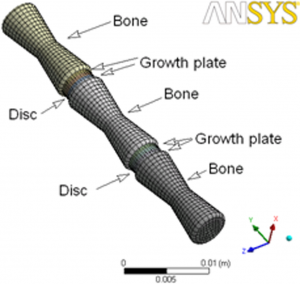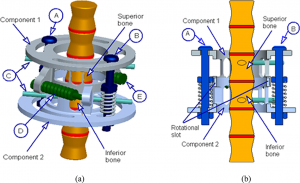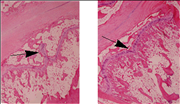This study seems to indicate that stretching may very well increase vertebral disc height.
Mechanics and Validation of an In-Vivo Device to Apply Torsional Loading to Caudal Vertebrae.
Torque is the force that rotates around an object. Torsion is the twisting of an object.
“Axial loading of vertebral bodies has been shown to modulate growth. Longitudinal growth of the vertebral body is impaired by compressive forces while growth is stimulated by distraction. The purposes of this study were two-fold: (1) to develop a torque device to apply torsional loads on caudal vertebrae and (2) investigate numerically and in vivo the feasibility of the application of the torque on the growth plate. A controllable torque device was developed and validated in the laboratory. A finite element study was implemented to examine mechanically the deformation of the growth plate and disk. A rat tail model was used with six 5-week-old male Sprague-Dawley rats. Three rats received a static torsional load, and three rats received no torque and served as sham control rats. A histological study was undertaken to investigate possible morphological changes in the growth plate, disk, and caudal bone. The device successfully applied a controlled torsional load to the caudal vertebrae. The limited study using finite element analysis (FEA) and histology demonstrated that applied torque increased lateral disk height and increased disk width. The study also found that the growth plate height increased, and the width decreased as well as a curved displacement of the growth plate. No significant changes were observed from the in vivo study in the bone. The torsional device does apply controlled torque and is well tolerated by the animal. This study with limited samples appears to result in morphological changes in the growth plate and disk. The use of this device to further investigate changes in the disk and growth plate is feasible.”

 Figures of the spine and of the torsion device.
Figures of the spine and of the torsion device.
 Left growth plate is under torsion whereas right is the control group. You can’t tell if there is any ectopic differentiation of MSCs to chondrocytes as the magnification isn’t high enough.
Left growth plate is under torsion whereas right is the control group. You can’t tell if there is any ectopic differentiation of MSCs to chondrocytes as the magnification isn’t high enough.
“Torsional loads are involved [in scoliosis]. While treatment of the spine to generate rotation by application of posterior flexure has been applied, it has been shown that the derotation maneuver using a posterior spine instrument does not consistently correct transverse rotation”
As torque increases, compressive loading becomes more tensile.
“[Torsional loading caused] remodeling at the epiphysial plate with bending of the cartilaginous columns of the growth plate”
5 week old sprague dawley rats were used.
“The morphology of the growth plate was seen to be more curved in the torque-loaded rat, while more flat in the sham rat”
“Overall, the growth plate area in the TG[Torque Group] (0.47 mm2) was greater than the area in the SG[Sham Group] (0.24 mm2)”
“lateral disk space was increased (55–65%), and the middle disk space was reduced by 15%”
“growth plate height is increased and its width is decreased [under torque]. The shear forces derived from the torque may stimulate greater number of endochondral cells in the proliferative zone compared to those in the control group with no shear forces.”
Note that under LSJL the growth plate curves in shape too. In contrast to the growth plates here, in LSJL the growth plates curve so that the center is the highest part of the growth plate. Although since only a small portion of the growth plate is shown in LSJL, it’s possible that in LSJL that the extremities curve upwards as well and it’s displaying the same center curvature as shown in these torsion growth plates.
“this curvature may be the result of the shear stress distribution in the growth plate. The sides of the growth plate are pushed toward the center by the shear stress, where the effect is most pronounced, leading to a curved appearance in the growth plate. This curved growth pattern forces the height of the center of the disk to decrease. Furthermore, the disk flows outward because of lower pressure at the outer boundary of the disk leading to increased disk width.”<-LSJL involves shear strain forces too which could also cause the curved shape.
 Left is growth plate under torque whereas right is control. You can definitely see the enhancement in growth plate quality.
Left is growth plate under torque whereas right is control. You can definitely see the enhancement in growth plate quality.
“0.07 mm increase in the disk height at the lateral side of the disk and no change in the disk height at the center of the disk.”
We’re looking mainly at disc height as there’s likely no growth plates in adult vertebrae.
There are 23 intervertebral discs which is 1.61mm total(or .161cm) if every disk gains 0.07mm. So assuming this a human being could gain 0.06 inches of height. Of course a human being is bigger than a rat so they would likely gain more mm’s than a rat. However, only the lateral side increases and not the center of the disc so you may not gain all the height.
Also, it’s not clear if there’s a limit on the height that can be gained this way.
Golfing, pitching, batting, throwing, twisting could all cause torque on the spine to various degrees.
Some stretches would also cause torque on the spine.
Too much torsion can cause hernias. So it seems as though for now twisting would have only a minor effect on height.

How much height increase one can expect with regular core stretching (not only switching) ?
I often heard people claiming having gained 2-3cm after a few years or regular streching.
Thanks, Fabien